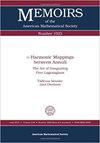Operator Theory on One-Sided Quaternionic Linear Spaces: Intrinsic S-Functional Calculus and Spectral Operators
IF 2
4区 数学
Q1 MATHEMATICS
引用次数: 19
Abstract
Two themes drive this article: identifying the structure necessary to formulate quaternionic operator theory and revealing the relation between complex and quaternionic operator theory. The theory of quaternionic right linear operators is usually formulated assuming the existenc of both a right- and a left-multiplication on the Banach space $V$, as the space of bounded operators on $V$ is otherwise not a quaternionic linear space. A right linear operator is however only associated with the right-multiplication and in certain settings, e.g. on Hilbert spaces, the left-multiplication is not defined a priori but must be chosen randomly. Spectral properties of an operator should hence be independent of this left multiplication. We show that results derived from functional calculi for intrinsic slice functions can be formulated without the assumption of a left multiplication. We develop the S-functional calculus in this setting and a new approach to spectral integration. This approach has a clear interpretation in terms of the right linear structure on the space and allows to formulate the spectral theorem without using any randomly chosen structure. Our techniques only apply to intrinsic slice functions, but only these functions are compatible with the basic intuition of a functional calculus that $f(T)$ should be defined by letting $f$ act on the spectral values of $T$. Using these tools, we develop a theory of quaternionic spectral operators. In particular, we show the existence of a canonical decomposition of such operator and discuss its behavior under the S-functional calculus. Finally, we show a relation with complex operator theory: if we embed the complex numbers into the quaternions, then complex and quaternionic operator theory are consistent. The symmetry of intrinsic slice functions guarantees that this compatibility is true for any imbedding of the complex numbers.单侧四元数线性空间的算子理论:内禀s泛函演算和谱算子
两个主题驱动这篇文章:确定必要的结构,以制定四元数算子理论和揭示复和四元数算子理论之间的关系。四元数右线性算子的理论通常是假设在巴拿赫空间$V$上同时存在右乘和左乘,否则$V$上的有界算子空间就不是四元数线性空间。然而,右线性算子只与右乘法有关,并且在某些情况下,例如在希尔伯特空间上,左乘法不是先验定义的,而是必须随机选择的。因此,算子的谱性质应该与这个左乘法无关。我们证明了从函数演算中得到的结果可以在不假设左乘法的情况下公式化。在此背景下,我们发展了s泛函演算,并提出了一种新的谱积分方法。这种方法对空间上正确的线性结构有一个清晰的解释,并且允许在不使用任何随机选择的结构的情况下表述谱定理。我们的技术只适用于内禀切片函数,但只有这些函数符合函数演算的基本直觉,即f(T)应该通过让f作用于T的谱值来定义。利用这些工具,我们发展了一个四元数谱算符理论。特别地,我们证明了这种算子的正则分解的存在性,并讨论了它在s泛函演算下的行为。最后,给出了与复算符理论的关系:如果将复数嵌入到四元数中,则复算符理论与四元数理论是一致的。内禀切片函数的对称性保证了这种兼容性对于任何复数的嵌入都是正确的。
本文章由计算机程序翻译,如有差异,请以英文原文为准。
求助全文
约1分钟内获得全文
求助全文
来源期刊
CiteScore
3.50
自引率
5.30%
发文量
39
审稿时长
>12 weeks
期刊介绍:
Memoirs of the American Mathematical Society is devoted to the publication of research in all areas of pure and applied mathematics. The Memoirs is designed particularly to publish long papers or groups of cognate papers in book form, and is under the supervision of the Editorial Committee of the AMS journal Transactions of the AMS. To be accepted by the editorial board, manuscripts must be correct, new, and significant. Further, they must be well written and of interest to a substantial number of mathematicians.

 求助内容:
求助内容: 应助结果提醒方式:
应助结果提醒方式:


